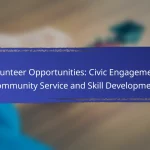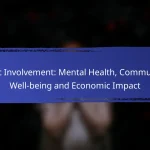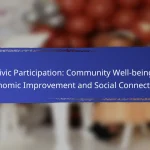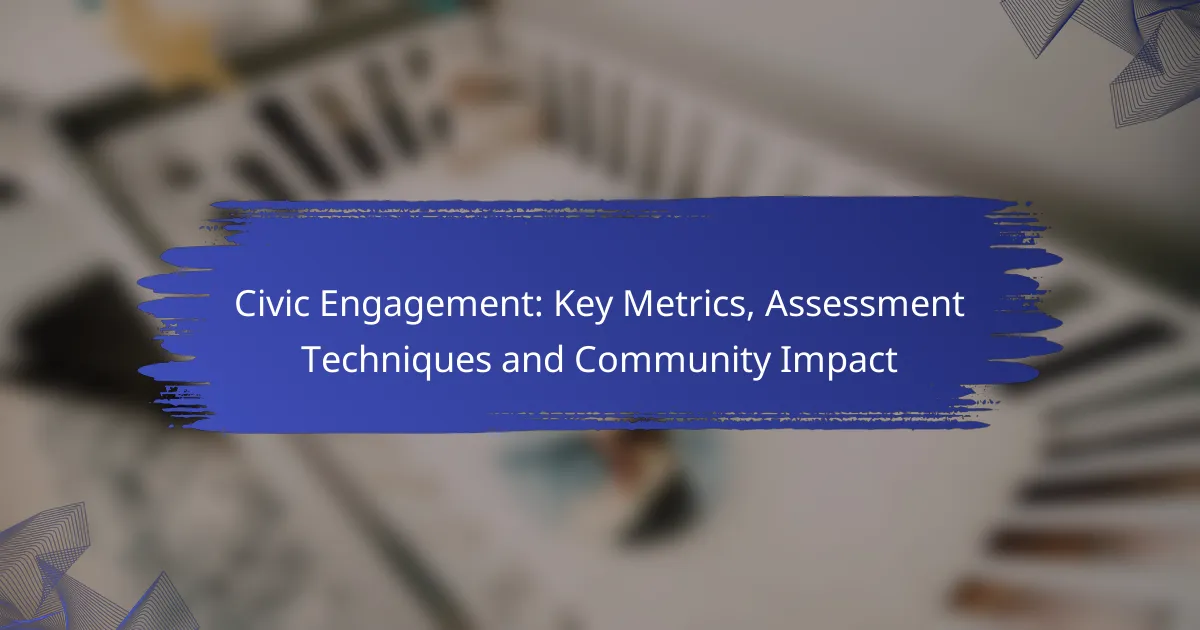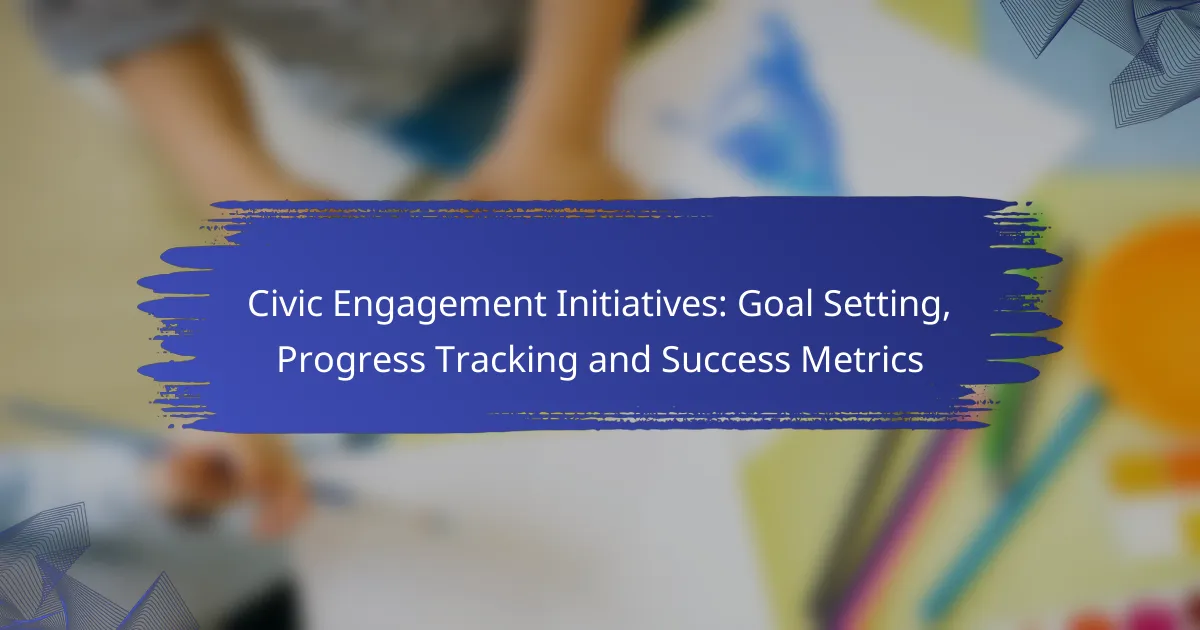Civic engagement is essential for fostering active participation in community life, and it can be measured through various metrics such as voting turnout, event attendance, and social media interactions. By employing assessment techniques like community surveys and public forums, organizations can gain valuable insights to tailor their initiatives effectively. Ultimately, enhanced civic engagement leads to improved governance and a stronger, more vibrant community fabric.
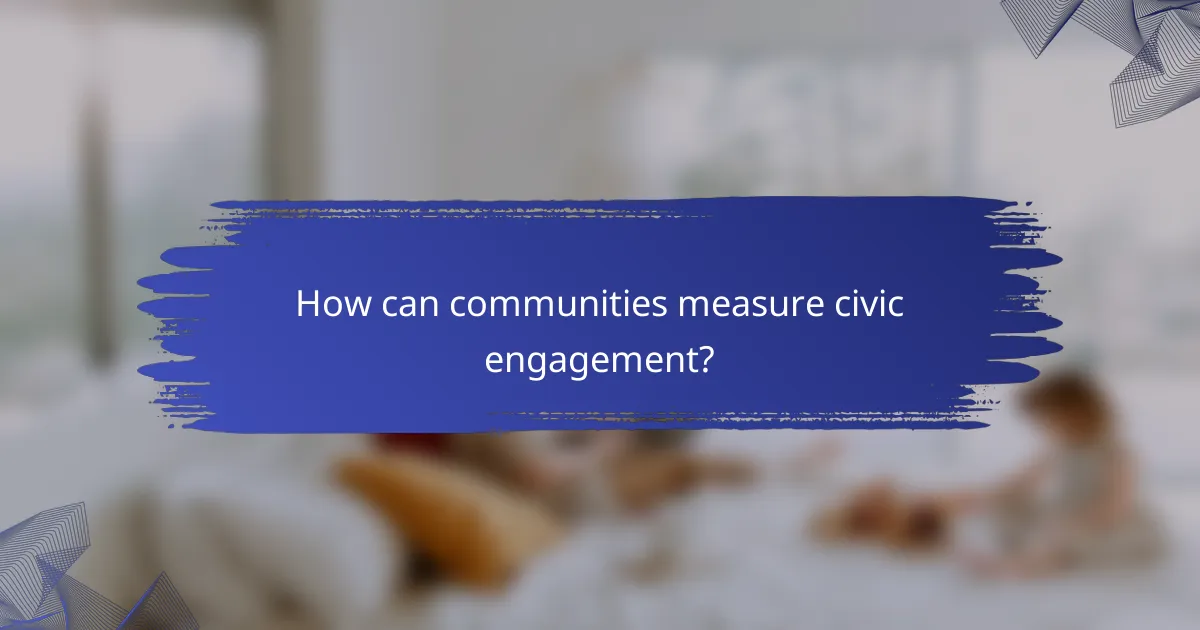
How can communities measure civic engagement?
Communities can measure civic engagement through various metrics that reflect participation and involvement in civic activities. Key indicators include participation rates, survey responses, voting turnout, event attendance, and social media engagement.
Participation rates
Participation rates indicate the percentage of community members actively involved in civic activities, such as town hall meetings or volunteer programs. Tracking these rates helps assess the overall engagement level within the community.
To measure participation rates, communities can compare the number of participants to the total population. For example, if a town has 1,000 residents and 200 attend a meeting, the participation rate is 20%. Regularly monitoring these rates can highlight trends and areas for improvement.
Survey responses
Surveys are effective tools for gauging community sentiment and engagement levels. By asking residents about their involvement in civic activities, communities can gather valuable insights into barriers and motivators for participation.
When designing surveys, ensure questions are clear and focused on specific aspects of civic engagement. Aim for a response rate of at least 20-30% to obtain reliable data. Consider using online platforms for wider reach and easier analysis.
Voting turnout
Voting turnout measures the percentage of eligible voters who participate in elections, serving as a critical indicator of civic engagement. Higher turnout rates often correlate with increased community involvement and awareness of local issues.
Communities can analyze voting data from local, state, and national elections to identify trends. For instance, a turnout rate of 60-70% is generally considered strong, while rates below 50% may indicate disengagement. Efforts to increase turnout can include voter education campaigns and simplifying the voting process.
Event attendance
Event attendance reflects how many community members participate in organized civic events, such as public forums, workshops, or cultural celebrations. Tracking attendance helps assess interest and engagement in community initiatives.
To enhance event attendance, consider factors like timing, location, and promotion. Offering incentives, such as refreshments or entertainment, can also boost participation. Collect feedback post-event to improve future offerings.
Social media engagement
Social media engagement measures how community members interact with civic-related content online. This includes likes, shares, comments, and overall reach of posts related to civic issues or events.
Communities can use analytics tools to track engagement metrics across platforms like Facebook, Twitter, and Instagram. Aim for consistent posting and interaction to foster a vibrant online community. Engaging content, such as polls or questions, can encourage participation and feedback.

What assessment techniques enhance civic engagement?
Assessment techniques that enhance civic engagement include community surveys, focus groups, and public forums. These methods help gather valuable insights from community members, enabling organizations to tailor their initiatives effectively.
Community surveys
Community surveys are structured questionnaires designed to collect data from a broad audience about their opinions and experiences. They can be distributed online or through paper forms, allowing for flexibility in reaching diverse demographics.
When designing a survey, keep questions clear and concise to encourage participation. Aim for a mix of multiple-choice and open-ended questions to capture both quantitative and qualitative data. A response rate of 20-30% is generally considered acceptable for community surveys.
Focus groups
Focus groups involve small, diverse groups of community members discussing specific topics related to civic engagement. These discussions provide deeper insights into community sentiments and can uncover issues that surveys might miss.
To conduct an effective focus group, select participants who represent various perspectives within the community. Sessions should be guided by a facilitator who encourages open dialogue while keeping the conversation on track. Typically, focus groups last about 1-2 hours and can yield rich qualitative data.
Public forums
Public forums are open meetings where community members can voice their opinions and engage in discussions about civic issues. These forums foster transparency and encourage active participation in local governance.
To maximize attendance and engagement, promote the forum widely through local media and social platforms. Consider using a structured agenda to guide discussions while allowing ample time for audience input. Public forums can vary in size, but aiming for at least 30-50 participants can lead to meaningful exchanges.
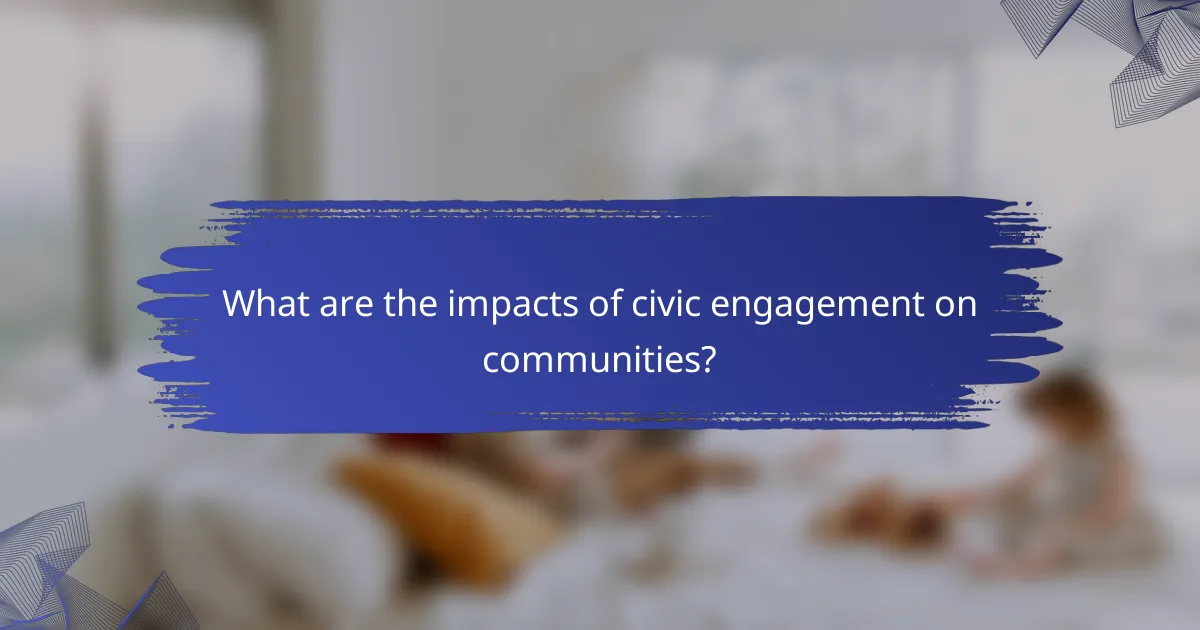
What are the impacts of civic engagement on communities?
Civic engagement significantly enhances communities by fostering participation in decision-making processes and improving the overall quality of life. Engaged citizens contribute to better governance, increased accountability, and a more vibrant social fabric.
Improved public services
Civic engagement leads to improved public services by allowing community members to voice their needs and preferences. When citizens participate in local governance, they can influence the allocation of resources, ensuring that services like education, transportation, and healthcare meet community demands.
For instance, public forums and surveys can help local governments identify priority areas for funding, resulting in more effective programs. Engaged communities often see enhancements in service delivery, such as shorter wait times and better access to essential services.
Increased trust in government
Active civic engagement fosters increased trust in government institutions. When citizens feel their voices are heard and their contributions valued, they are more likely to have confidence in public officials and processes.
Transparency initiatives, such as open meetings and accessible information about decision-making, can further strengthen this trust. Communities that engage in dialogue with their local governments often report higher levels of satisfaction with governance and a willingness to participate in future civic activities.
Stronger community ties
Civic engagement cultivates stronger community ties by bringing individuals together around common goals and interests. Participating in local events, volunteer opportunities, and advocacy efforts helps build relationships and a sense of belonging among residents.
Community projects, such as neighborhood clean-ups or local festivals, not only enhance the environment but also create networks of support among residents. These connections can lead to collaborative problem-solving and a more resilient community overall.

Which tools facilitate civic engagement assessments?
Several tools are designed to facilitate civic engagement assessments, providing platforms for gathering community feedback and measuring participation. These tools help organizations understand public sentiment and improve their engagement strategies.
Polco
Polco is an online platform that allows local governments to gather feedback from residents through surveys and polls. It enables civic leaders to assess community priorities and satisfaction levels effectively.
Using Polco, municipalities can create targeted questions to gauge public opinion on specific issues, such as budget allocations or policy changes. This tool is particularly useful for enhancing transparency and accountability in local governance.
EngagementHQ
EngagementHQ is a comprehensive engagement platform that supports various methods of community involvement, including surveys, discussions, and interactive mapping. It allows organizations to tailor their outreach efforts based on community needs.
This tool features analytics that help assess engagement effectiveness, enabling users to track participation rates and demographic insights. EngagementHQ is ideal for organizations looking to foster deeper connections with their communities.
CitizenLab
CitizenLab is designed to empower local governments and organizations to engage citizens in decision-making processes. It offers tools for surveys, idea collection, and collaborative discussions, making it easier to involve residents in shaping policies.
With CitizenLab, users can analyze feedback and visualize data to understand community perspectives better. This platform is particularly beneficial for cities aiming to enhance civic participation and improve public services.
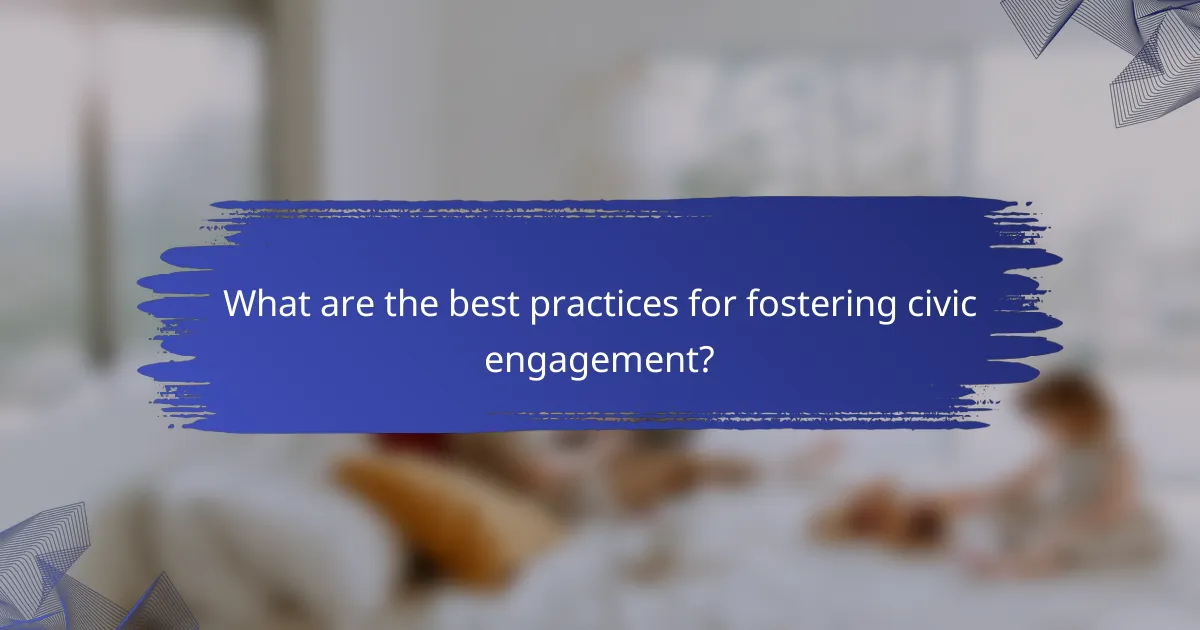
What are the best practices for fostering civic engagement?
Fostering civic engagement involves creating opportunities for community members to participate actively in public life. Effective practices include inclusive outreach strategies and collaborative decision-making processes that empower individuals and build trust within communities.
Inclusive outreach strategies
Inclusive outreach strategies are essential for ensuring that all community members have the opportunity to engage. This can involve using multiple communication channels, such as social media, community meetings, and local events, to reach diverse populations. Tailoring messages to resonate with different cultural backgrounds can enhance participation.
Consider organizing outreach efforts in collaboration with local organizations that already serve underrepresented groups. This can help to build credibility and trust, making it more likely that individuals will participate in civic activities.
Collaborative decision-making
Collaborative decision-making promotes civic engagement by involving community members in the processes that affect their lives. This can be achieved through town hall meetings, focus groups, or participatory budgeting sessions where residents can voice their opinions and contribute to decision-making.
To implement effective collaborative decision-making, ensure that meetings are accessible and provide necessary resources, such as translation services or childcare. Encouraging a culture of respect and open dialogue can help mitigate conflicts and foster a sense of ownership among participants.


